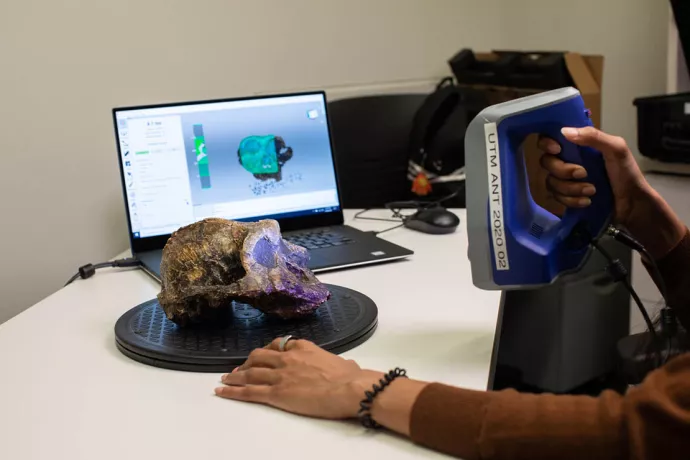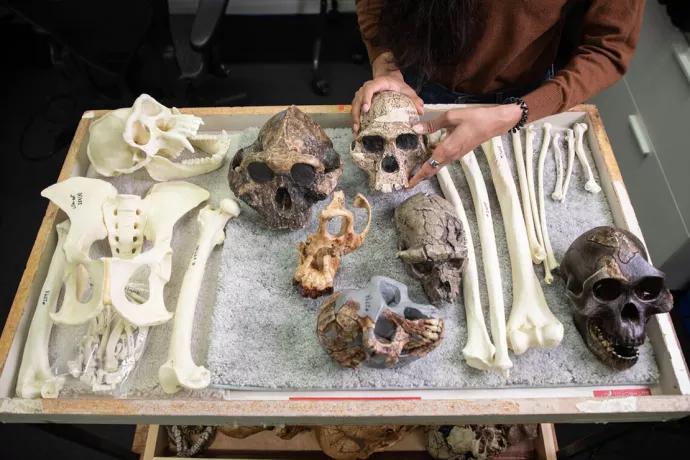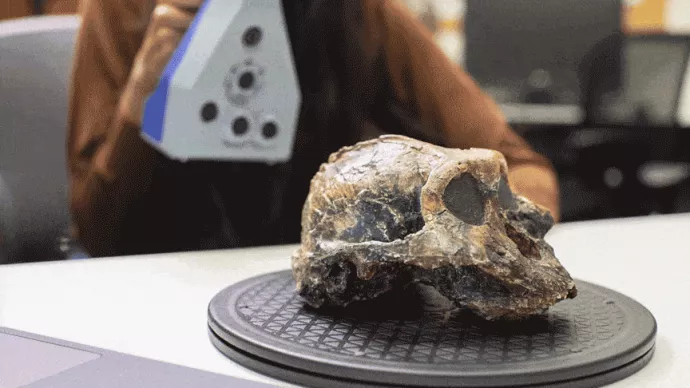Virtual labs: Skulls, bone fragments and fossils come to life with 3D scanner

In a small room at U of T Mississauga’s Terrence Donnelly Health Science Complex a cast of a hominin skull is carefully being scanned. Its prominent features, distinguishing characteristics and even the smallest surface details are all replicated in exacting detail as part of a project that’s bringing fossils into the digital realm.
The skull is one of hundreds of specimens being added to an online 3D digital database for anthropology students who can’t access bone casts and fossils in-person due to the pandemic.
Lauren Schroeder, an assistant professor of anthropology, knew she had to find a way to get lab specimens in the hands of her students after classes moved online. She and her TA scoured the web for resources they could use in a virtual lab, but it was difficult to find all the material in one place, and many specimens weren’t available.
That’s when she and her colleagues decided to create their own digital database from their teaching collection. Her colleagues at St. George had access to a 3D scanner while UTM’s anthropology department had recently purchased a handheld 3D scanner capable of rendering complex objects in fine detail.
“We were really lucky,” Schroeder says. “Things just fell into place.”

Anthropology professors Bence Viola and Michelle Cameron, who each teach similar courses, are also scanning their teaching collections at St. George. With some overlap in the campus collections, the three colleagues are using a shared spreadsheet to track scans so they can spread the workload and avoid duplicating efforts.
“We’ve spent more than 100 hours scanning specimens already,” says Viola, whose graduate student has already scanned a full male and female skeleton, bone-by-bone. “It’s a significant investment, but it’s important. It’s the only way to teach this year.”
He explains that the scanning process is slow because the high-resolution models need to show the smallest surface details. While some models can be shared with a broader audience, scans of real bones or copyrighted fossils will only be available to students.
Hundreds of specimens from UTM’s teaching collection – mostly consisting of casts of hominin skulls and primate post-cranial material (like leg bones) – are being scanned for Schroeder’s upcoming second year anthropology class, Biological Anthropology: Primatology and Palaeoanthropology, which starts in January.
“The course provides an overview of skeletal anatomy across multiple species of primate, including us,” Schroeder says, noting the course has a significant lab component that consists of activities using bone casts (not the bones themselves).

The 3D digital models imitate the specimens students would normally work with during an in-person lab. Students can interact with the virtual models, turning them, zooming in on points of interest and noting surface details. The models are also annotated, drawing attention to certain features students will need to recognize.
While the pandemic is what spurred this project, both Schroeder and Viola see opportunities to use the newly digitized teaching collection in conjunction with hands-on learning when labs re-open. Students can use the digital models for review, special assignments, or even as a way to virtually take a specimen home for further study, something not possible with the real objects. Viola refers to the database as a “virtual textbook” students can always use. The 3D digital models can also be used by professors for tests and exams, and even by researchers out in the field.
Creating a cross-campus digital collection also has the potential to broaden what students can access. Each campus offers different anthropology specializations and slightly different courses. With that comes access to some specialized collections. By creating a digitized database, specimens unique to one campus can be scanned into the system for use across the university.
“I think it’s a great opportunity for students to see what other people do and learn from experts on other campuses,” Viola says.



